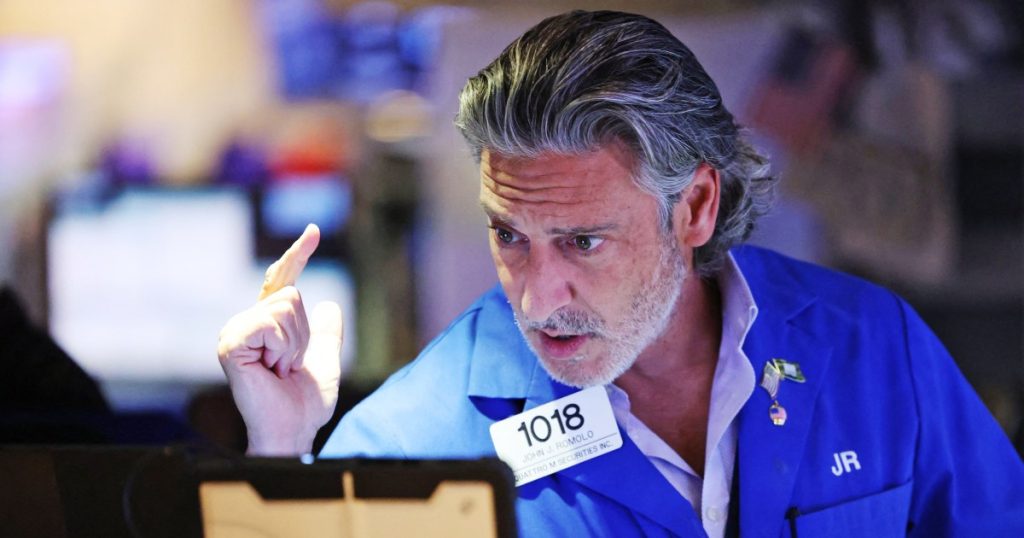Summarize this content to 2000 words in 6 paragraphs Stock indexes saw a mild rebound following a significant sell-off Monday that resulted in the market’s worst day in almost two years. The S&P 500 and the tech-focused Nasdaq Composite both closed up 1% higher. The Dow Jones Industrial Average was up 0.7%, or about 300 points. Leading the rally was Nvidia, which has led the entire market for much of the year thanks to the importance of its chips for artificial intelligence programming. It finished 4% higher after falling 7% Monday. Meta, the parent company of Facebook, also climbed 4% Tuesday. Uber, which reported strong earnings early Tuesday, soared 11%. Tuesday’s recovery came as Japan’s Nikkei stock index, which saw its worst day in a generation Monday, rallied for its best day since 2008, surging 10.2% A trader works on the floor of the New York Stock Exchange ahead of the closing bell on Aug. 5, 2024. Charly Triballeau / AFP – Getty ImagesStill, the day’s gains won’t make up for the losses stocks suffered Monday, when the Dow plunged more than 1,000 points, or 2.6%, the S&P fell 3% and the Nasdaq dropped 3.4%.But the indices remain higher for 2024, with the Dow up about 3.5%, the S&P 500 up about 10% and the Nasdaq up about 9.5% since the start of the year.Some market participants said Monday’s tumble was overdone. In a note to clients Tuesday, Goldman Sachs analysts noted central banks like the Federal Reserve “are no longer constrained by the fear of high inflation” and are ready to lower interest rates. Plus, investors across the spectrum have built up “very significant cash piles” that can be used to purchase stocks at their suddenly lower prices, they wrote. And debt among firms remains low, meaning they “can absorb the impact of weaker growth better than in many other downturns.”Yet, there remains disagreement about how fast the economy is slowing. Analysts with Citibank said Tuesday that they disagreed with the notion that Friday’s jobs report, which showed unemployment unexpectedly increasing to 4.3% and just 114,000 jobs added in July, was an outlier data point, as has been suggested by at least two regional Federal Reserve presidents.”The unfortunate reality is that a range of data confirm what the rise in the unemployment rate is now prominently signaling — the U.S. economy is at best at risk of falling into a recession and at worst already has,” they wrote in a note to clients Tuesday, pointing to a range of data — from a hiring rate that’s slowed to a crawl to increasing unemployment claims — that things are worse than they seem. The focus remains on what the Federal Reserve, which is in charge of balancing inflation and jobs growth via raising and lowering the cost of borrowing, will do after announcing last week that it was leaving rates unchanged.That decision has now come to be seen by some analysts as a mistake. The Citi analysts said a larger-than-usual 50-basis-point rate cut by the Fed at its next meeting in September is now the most likely scenario and that a potential inter-meeting cut — usually done only in emergencies — is “on the table.” “Data over the next month is likely to confirm the continued slowdown,” they wrote. Still, others argued there is zero chance that the Fed would make such a move, which is usually reserved for extreme scenarios like the Covid pandemic. Torsten Slok, chief economist at Apollo Global Management, said in a note Tuesday that the economy remains in decent shape. His case was bolstered by the latest real-time data on gross domestic product from the Atlanta Federal Reserve Tuesday, which showed Q3 GDP tracking 2.9%, up from 2.5% last week. “If the economy were crashing, default rates would be spiking higher, and that is not what the data shows.” he wrote.
You Might Like
© 2024 West Timelines. All Rights Reserved.


